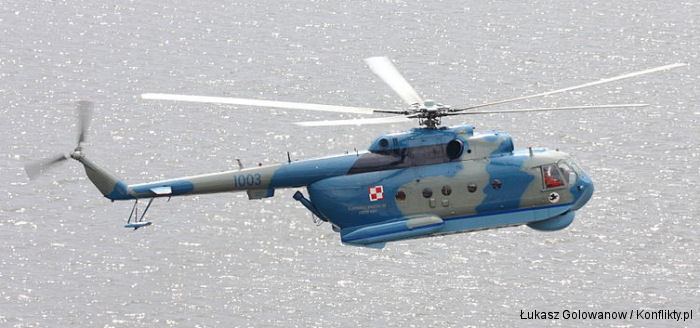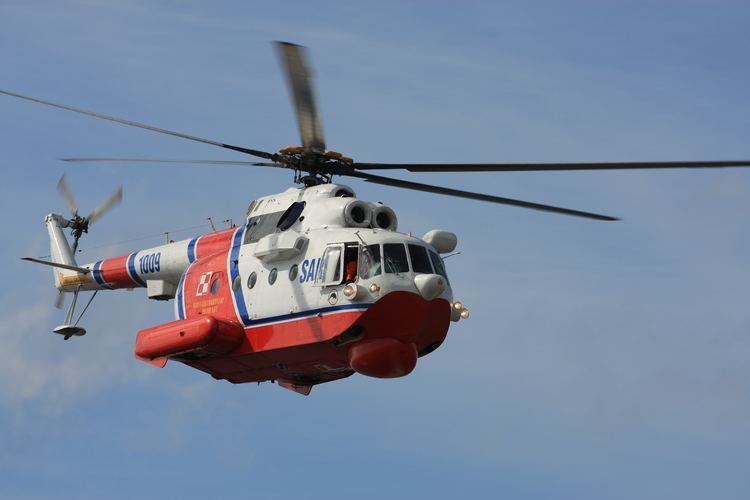Top speed 230 km/h Length 18 m Engine type Klimov TV3-117 | Wingspan 21 m Introduced 1975 First flight September 1969 | |
 | ||
Manufacturer | ||
Mil mi 14
The Mil Mi-14 (Russian: Миль Ми-14, NATO reporting name: Haze) is a Soviet shore-based nuclear-capable amphibious anti-submarine helicopter derived from the earlier Mi-8.
Contents
- Mil mi 14
- Landing on rough seas mil mi 14 japan 2016
- Design and development
- Variants
- Operators
- Current operators
- Former operators
- Specifications Mi 14PL
- References

Landing on rough seas mil mi 14 japan 2016
Design and development

Formal development of an anti-submarine warfare (ASW) version of the Mil Mi-8 transport helicopter was authorised by the Soviet Communist Party Central Committee and Council of Ministers in April 1965, with the objective of replacing the Mil Mi-4 in the short-range, shore based anti-submarine role. The new helicopter was required to have an endurance of 2 hours on station at a radius of 222 kilometres (120 nmi; 138 mi) from base.

The new design (with the internal designation V-14) differed from the Mi-8 in having a boat-like hull similar to the Sea King, allowing it to operate off the water, and a retractable four-point undercarriage, with the mainwheels retracting into large sponsons on the rear of the fuselage. The helicopter was to be powered by two Klimov TV3-117MT turboshaft engines. A watertight weapons bay is fitted to the centreline of the fuselage allowing internal carriage of a single torpedo or eight depth charges, while a radome housing a search radar is fitted beneath the nose.

The first prototype V-14, converted from a Mi-8 and powered by the older and less powerful Klimov TV2-117 engines, flew on 1 August 1967. Development was slowed by problems with the helicopter's avionics and due to reliability problems with the TV3-117 engines, with production at Kazan not starting until 1973, and the helicopter (now designated Mi-14) entering service on 11 May 1976.

Allegedly due to the strong pressure from the United States, all Russian antisubmarine Mi-14 helicopters were decommissioned in 1996. In May 2015, RT has reported that Mi-14 is being highly sought after by the Russian Black Sea and the Northern Fleets, and that Kazan Helicopter Works (KVZ) is preparing to return 10 previously decommissioned helicopters to active Russian Navy service with the production of new units beginning within five years. The initial demand was estimated at 100 helicopters.
In January 2016, Russian Helicopters confirmed to Russian News Agency TASS that no final decision to revive production had been taken, but market demand, feasibility studies – including with Moscow’s defence ministry – and funding sources were under review. The programme remains a “priority” for Russian Helicopters. The company suggested the Mi-14 would appeal to civil operators in Russia’s far north and those supplying the oil and gas industry, alongside the nation’s armed forces. Out of the almost 300 Mi-14s produced at Kazan Helicopters between 1973 and 1986, it is estimated that just 44 examples remain in active service.
Variants
Operators
By 1991, about 230 had been delivered, with exports to many Soviet allies including Bulgaria, Cuba, East Germany, Libya, Poland, and Syria.
Current operators
Former operators
Specifications (Mi-14PL)
Data from Jane's All The World's Aircraft 1992–93 & http://fas.org
General characteristics
Performance
Armament
